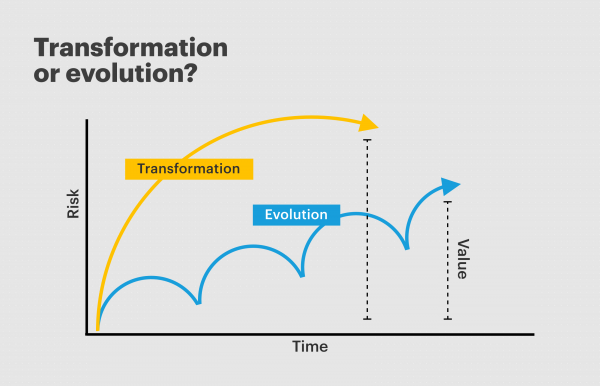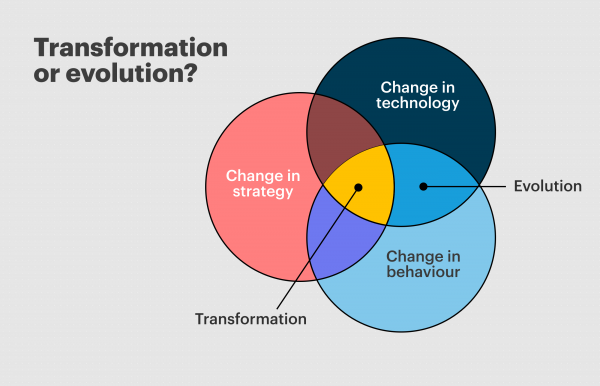Watene Hema: Scholarship ignites drive and purpose
Find out why Watene Hema came away from the Risk Assessment course with a greater understanding of what risk really means.
Transformation needs a strategy, not just new technology.

OPINION: We’re two years into a global pandemic that has rapidly changed the way organisations work and the tools being used. We’re all being more digital.
Does that mean Covid-19 has delivered a digital transformation for your organisation? Or was it a necessary evolution? What exactly is a digital transformation? And do you actually want one?
Right now, what most people are doing hasn’t fundamentally changed; we’re doing the same things in different ways. For the people lucky enough to be able to work from home, a face-to-face meeting has become a Zoom, Teams or Hang Out. For those who collaborated on whiteboards on a daily basis, it’s become a Miro or a Mural. The tasks remain but the tools have changed.
The driver for this change was necessity. If you wanted to keep working, you had to Zoom. It accelerated existing trends and behaviors in response to changing circumstances. It was a successful digital evolution because the required change was not unsurmountable; tools like Zoom and Miro are fairly easy to use.
In contrast, the driver for a digital transformation should be to increase the value an organisation delivers. This can be done by taking advantage of an opportunity and doing something new, or by doing the same things better and more efficiently. It’s possible to do both.
The difference between an evolution and a transformation lies in the first pillar of The Four Pillars of Governance Best Practice: it is purpose. An evolution is typically a natural response to a need. A transformation must have a bigger goal in mind, and therefore requires clear leadership. To be a transformation, it requires a change in your organisation’s strategy. You lead with transformation, you respond via evolution.
Think about that as a director of your organisation: when was the last time you provided digital leadership? When was the last time the board assessed digital options for your organisation and proactively mapped out where you wanted your technology to take you? What set of digital projects and activities did you invest in to get to that destination? And once set, how did the board or committee guide the transformation?
Most of the time, boards and organisations respond to technology needs. You are constantly responding to things like software upgrades, cyber threats, hardware obsolescence and ever-changing business and compliance requirements. Each response requires a small change and a little evolution. If the project goes well it’s normally a step forward. You can survive through this incremental evolution, but are you missing the chance to thrive with transformation? What role should the board play in determining if evolution or transformation is the best path forward?

A digital transformation requires real leadership and deliberate change intended to move your organisation to a better position. In most digital transformations, the change impacts every part of your business — both internal (the way you and your team work) and external (the way people engage with your business).
A definition for digital transformation could be: a shift in strategy that triggers a set of technology changes that affect everyone. The beauty of this definition is that it’s led by strategy, focused on people, and it scales. A small or newer organisation can more easily change direction and the way everyone works. A large or legacy organisation can transform, but can’t do so as easily, and doing so requires significant time and risk.
It’s important to keep in mind that doing a digital transformation is not the goal in itself, the goal is to increase value. It is actually better to successfully evolve than fail to transform. If you are not changing your organisation’s strategy, you don’t need a digital transformation. And if change is being driven by technology rather than strategy, it’s not a transformation.
Let’s say that your company undertakes research to understand how customers want and expect to be served in a digital world. It then sets out to transform its website, mobile app, social media, sales and finance platforms, as well as closing physical stores and retraining staff to focus on online sales. The purpose is clear: provide excellent service using your customers’ favorite channel. The goal is to increase value through attracting new customers and retaining existing ones. These changes result in your company shifting from doing 20% of its business online to over 80%.
It’s a true digital transformation because you and every other person and process — internal and external — have been impacted. Because transformations are actually more about people, a transformation like this only succeeds if as much effort is put into change management and training as is put into the technology. As an individual, it’s easier to evolve naturally than be told to transform.
By comparison, changing your website (perhaps led by the marketing department) or replacing your asset management or CRM platform (often led by IT) are not transformations on their own. Yes, they can affect many people but they won’t impact everyone, and won’t necessarily change the way you work or generate new value for your organisation. They are very important projects in of themselves, they are evolutions, but without coordinated leadership, they cannot transform an organisation.

So has your organisation recently transformed or evolved? What role has Covid-19 played? The truth is, there are very few successful, long-lasting digital transformations. More commonly, there is a lot of excellent evolution.
If now is not the time for you to tackle a transformation, that’s OK. But make sure your organisation is evolving. Make sure your organisation is being more digital, and doing more digital. By being and doing you are laying the foundations for transformation when the right opportunity presents itself.
Also by Tom Hovey: Are you getting the best results from your digital project?

Tom Hovey MInstD is a creative consultant with over 25 years of digital experience working in New Zealand and the United Kingdom. Tom helps organisations develop digital strategies that deliver meaningful results.
The views expressed in this article do not reflect the position of the IoD unless explicitly stated.
Contribute your perspectives and expertise on an area of governance to the IoD membership and governance community. Contact us mail@iod.org.nz